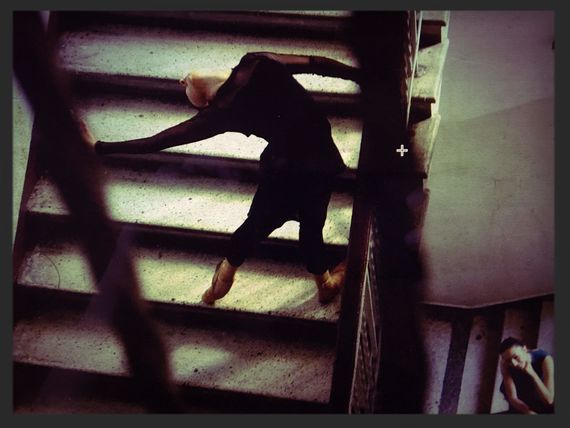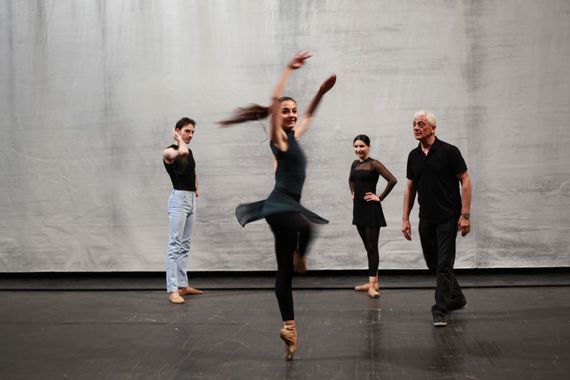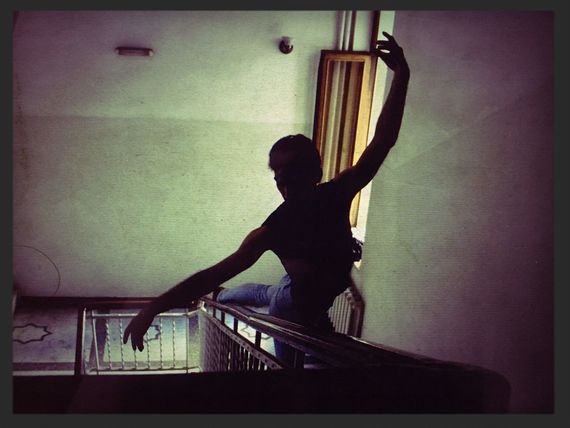I started to dance when my subconscious was still asleep and my body was forcing me to be free and take flight on stage.
I was young and it was hard to imagine how it would be in six or seven years, but one thing was certain, I was going to dance in the ballet and live on the stage.
It was on that very stage that I lost my freedom, my flight. One injury and I had to forget about the ballet, but even then they said society rejects the ballet and I would never make a living at it anyway.
At the beginning of the 20th century, when Armenia was already sovietized, following long years of war and under new and peaceful conditions, art was given a chance to become a part of the institutional fabric of society. Beyond the struggles of daily life, people were free to choose to be interested in or to be a part of the arts. But freedom in art still would remain in the future.

Dancers on the stairs of Armenia's National Academic Theatre of Opera and Ballet named after Alexander Spendiaryan.
The situation changed after independence; there was freedom to be found in art but to choose art unreservedly, seemed ill-founded. Day-to-day struggles brought forth a dimension where the audience and the dancer were not connected.
Fast forward 30 years and the dancer whose dreams of the grand stage were crushed, is also confronted with the apathy of Armenian society. The new production at the National Opera and Ballet Theater fills only a third of the hall. The rows are full only on opening night and not always, often thanks to invitations. Tickets remain at the box office and dreams of bursting theaters remain unattainable once again.
“The ballet mostly represents abstract thinking but, in general, Armenians like things to be tangible,” says choreographer, painter and former ballet dancer Rudolf Kharatian, who was the Principal Choreographer and Artistic Director of the National Ballet of Armenia until 2014. “They want to feel it - this is a car, this is bread, this is the physical world. The theater itself is also split into two - realism and abstract thinking. In ballet, reality is organized on the stage, on a square platform, you can compose and create an invisible world. It is the spiritual notion that everything is much wider than ‘me’ and the ‘physical world.’”

Rudolf Kharatian (right) working with dancers.
According to Kharatian, Armenia today represents that physical world. “In reality, we lost one part of this connection and it is for that reason everything for us is black and white,” he says. “The ballet can create a certain emotion when the audience is watching, when they love what they see even though they may not always understand it. The ballet urges you to connect, remember or remind and spur that which is inside you.”
I was soaring in the air and then over the stage. My eyes were closed yet I could feel the applause. Hands stretched out above my head I was playing in the air. The stage was saying you have wings, and I took flight; it was saying, you are of the earth, and I could feel that which is constant with the ends of my feet. I was the abstraction of the theater and with my eyes closed, I knew I had an audience. My eyes opened, it was a birthday party at a restaurant and I was dancing, but it was not ballet. The theater audience is not here, the truth at a restaurant is different - dreams and goals are different here.
Ellen Khachikyan is another 22-year-old dancer who cherishes her childhood dreams of ballet, even when her connection to ballet was interrupted after she graduated from the academy and she found herself dancing in an unfamiliar environment. During her studies at the State College of Dance she would take part in different performances and in 2011 was on the stage of the children’s Eurovision contest. After graduation, she started working at restaurants and made appearances on Shant TV and public television. Now she now works in Taiwan, she dances there and as she puts it, she educates her dancing body to return with renewed vigor. In Taiwan, there is the stage, the performance and there is an engaged audience, the restaurant is not part of the equation.
The leap from the ballet stage to the restaurant scene was about earning money and the need to be appreciated.
“I had friends who were dancing at restaurants, I got an offer to dance as well and when I realized it was a way to earn back the money and compensate for the effort I had put into my classical education, I accepted the first offer I got.” Ellen says that a part of her inner world continually battled with the dancer in her. When the mind cheats itself, there is no rest.
The obvious pubic apathy can be disheartening but to the question if classical arts have stopped being of interest to the Armenia society, Ellen thinks there is an apparent apathy, but it comes from a lack of information, from not having the chance to experience beauty as children. She sees the solution in the combination of the classic and the contemporary. Maybe you can attain an interest towards the classical though the contemporary, says Ellen.
I continue to dance because the stage is the only place (at least for me) to express emotions and acquire new ones...
I will abandon the stage when… “Never.”
The ballet gave me … “Freedom to express emotions.”
What is ballet like away from the stage? My feet hurt from standing on pointes and I still dream about Spartacus but I put on multicolored costumes and show up to dance Hayk and Bel.
Ellen
Gagik Tadevosyan started his dancing career at the Gevorgyan Dance Center and later entered the Pedagogical University's Faculty of Culture and Dance. Since 2010, he is the soloist of the "Berd" Ensemble. He has danced in the Anush Opera, where he performed in France.
During the first half of the day, he is on stage, feeling the ballet, living on the stage and hearing the applause. The second half of the day, he is in the restaurant, dancing modern, Armenian folk, Georgian, etc. He started dancing at the restaurant when he was admitted to university, because as Gagik points out he was a student and needed to work.
When we were taking photos at the Opera and Ballet Theater, we saw a precise pirouettes, firm and stable hands. He was dancing and watching with the eyes of a spectator, there was ballet, classical art. The tables in the restaurant were full, Gagik danced while they celebrated a birthday. Gagik was dreaming, the others were wishing that dreams come true.
“At first there was an unusual feeling, it was conflicting that the same spectator sees us on the stage and then at the restaurant during the show.”
“The hall is full when you feel like you are valued after the performance. However, at the same time, I can’t deny the fact that there is an absence of spectators who are interested. As dancers, we would be pleased to see youngsters who are interested in classical art and ballet. I knew a soldier from Tavush marz, who once told me that he had heard about the opera from his math teacher. In class, the math teacher said that if you are able to listen to the opera for ten minutes, then you can be considered as a developed person. The problem is in fact deep, because young people are not informed.”
Gagik sees the possible solution in school children. He says it would be interesting if children were introduced to classical art from a young age.

Warming up on the stairs of the National Academic Theatre of Opera and Ballet.
Rudolf Kharatian says more discipline is required to present the physical world in spirituality. Folklore can simply cause emotions that are specific to ethnicity. It is important to understand what is more universal. Rudolf insists that many dancers do not know what they are transmitting through their hands, their feet. “Everything that I learned through martial arts, yoga or ballet rests upon one thing - that is the art of speaking with God that connects you to your eternity. It's hard to imagine what the ballet is like off the stage. Unfortunately, sometimes, the stage is also an artificial barrier between society and the dancer. They dance, believing that one day with the freedom of a swan, they will be worthy of a full theater and applause. The halls are half empty, restaurants are full, and the dancer has a lack of interested spectators. Beyond the stage, the ballet lives, the only thing that remains is for the spectator to be close to beauty and in this case, the applause will never be absent.”



